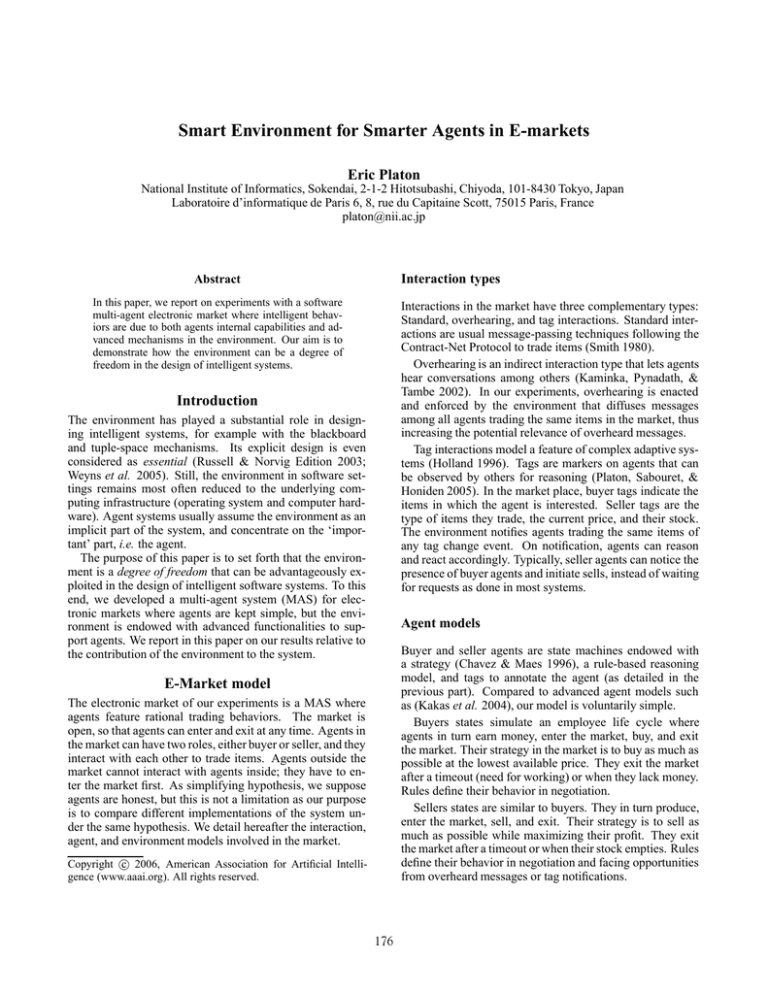
Smart Environment for Smarter Agents in E-markets
Eric Platon
National Institute of Informatics, Sokendai, 2-1-2 Hitotsubashi, Chiyoda, 101-8430 Tokyo, Japan
Laboratoire d’informatique de Paris 6, 8, rue du Capitaine Scott, 75015 Paris, France
platon@nii.ac.jp
Interaction types
Abstract
In this paper, we report on experiments with a software
multi-agent electronic market where intelligent behaviors are due to both agents internal capabilities and advanced mechanisms in the environment. Our aim is to
demonstrate how the environment can be a degree of
freedom in the design of intelligent systems.
Interactions in the market have three complementary types:
Standard, overhearing, and tag interactions. Standard interactions are usual message-passing techniques following the
Contract-Net Protocol to trade items (Smith 1980).
Overhearing is an indirect interaction type that lets agents
hear conversations among others (Kaminka, Pynadath, &
Tambe 2002). In our experiments, overhearing is enacted
and enforced by the environment that diffuses messages
among all agents trading the same items in the market, thus
increasing the potential relevance of overheard messages.
Tag interactions model a feature of complex adaptive systems (Holland 1996). Tags are markers on agents that can
be observed by others for reasoning (Platon, Sabouret, &
Honiden 2005). In the market place, buyer tags indicate the
items in which the agent is interested. Seller tags are the
type of items they trade, the current price, and their stock.
The environment notifies agents trading the same items of
any tag change event. On notification, agents can reason
and react accordingly. Typically, seller agents can notice the
presence of buyer agents and initiate sells, instead of waiting
for requests as done in most systems.
Introduction
The environment has played a substantial role in designing intelligent systems, for example with the blackboard
and tuple-space mechanisms. Its explicit design is even
considered as essential (Russell & Norvig Edition 2003;
Weyns et al. 2005). Still, the environment in software settings remains most often reduced to the underlying computing infrastructure (operating system and computer hardware). Agent systems usually assume the environment as an
implicit part of the system, and concentrate on the ‘important’ part, i.e. the agent.
The purpose of this paper is to set forth that the environment is a degree of freedom that can be advantageously exploited in the design of intelligent software systems. To this
end, we developed a multi-agent system (MAS) for electronic markets where agents are kept simple, but the environment is endowed with advanced functionalities to support agents. We report in this paper on our results relative to
the contribution of the environment to the system.
Agent models
Buyer and seller agents are state machines endowed with
a strategy (Chavez & Maes 1996), a rule-based reasoning
model, and tags to annotate the agent (as detailed in the
previous part). Compared to advanced agent models such
as (Kakas et al. 2004), our model is voluntarily simple.
Buyers states simulate an employee life cycle where
agents in turn earn money, enter the market, buy, and exit
the market. Their strategy in the market is to buy as much as
possible at the lowest available price. They exit the market
after a timeout (need for working) or when they lack money.
Rules define their behavior in negotiation.
Sellers states are similar to buyers. They in turn produce,
enter the market, sell, and exit. Their strategy is to sell as
much as possible while maximizing their profit. They exit
the market after a timeout or when their stock empties. Rules
define their behavior in negotiation and facing opportunities
from overheard messages or tag notifications.
E-Market model
The electronic market of our experiments is a MAS where
agents feature rational trading behaviors. The market is
open, so that agents can enter and exit at any time. Agents in
the market can have two roles, either buyer or seller, and they
interact with each other to trade items. Agents outside the
market cannot interact with agents inside; they have to enter the market first. As simplifying hypothesis, we suppose
agents are honest, but this is not a limitation as our purpose
is to compare different implementations of the system under the same hypothesis. We detail hereafter the interaction,
agent, and environment models involved in the market.
c 2006, American Association for Artificial IntelliCopyright gence (www.aaai.org). All rights reserved.
176
Environment model
than in the other configurations, so that the difference between the two systems becomes insignificant. A similar result holds for B4-S20, which is in addition a rare case in
practice. The largest difference is in the case B20-S4, which
is the more realistic in a real market.
In contrast with Fig. 1, the analysis of the simulation logs
showed that seller agents earn less and buyer agents consume less when interacting through the environment. This
result can be explained with the computational cost of overhearing and tag interactions that require sending more messages and events in the market.
The environment focuses on agent interaction enactment and
regulation. The environment enacts overhearing and tag interactions, as presented in the interaction section. Overheard
and tag messages are diffused according to the agent trading
items so as to increase the potential information relevance to
receiving agents.
In addition, the regulation provided by the environment is
the application of a set of rules. In the case of our electronic
market, the only rule is to enforce a level of honesty. The
environment prevents agents to set prices out of the market
price range. Sellers can attempt to expose a price for advertising their items. If the price is out of the market range,
the environment is responsible for changing the value to the
closest allowed one.
Conclusion
Our experiments show in a simple case that the environment contributes significantly to the agent performance in
trading items. The environment does not replace the agent,
but it completes it and ‘makes it smarter’. The environment
is therefore an exploitable degree of freedom in the design
of intelligent software systems. Further work aims at exploring more complex settings where the environment could
contribute to advanced agent architectures, and identifying a
methodology on how to design the appropriate environment
for a given application.
Experiments and Results
Our experiments compare an electronic market with only
standard interactions (baseline system) to the same market
extended with overhearing and tag interactions. The criteria
of comparison is the number of failed deals in the market,
i.e. when agents fail to contract.
This criteria allowed us to appreciate some characteristics
of the two systems in several configurations. The number of
agents varied from 4 to 20 of each type with different ratios
of buyers and sellers, and simulation lengths varied from 4
seconds to one hour. Each configuration of the two systems
ran up to 100 times to provide mean and standard deviation values for the aforementioned criteria. The main results
from our experiments are shown on Fig. 1 in five configurations.
Acknowledgment
The author would like to thank Shinichi Honiden and Nicolas Sabouret for their constant support.
References
Chavez, A., and Maes, P. 1996. Kasbah: An agent marketplace for buying and selling goods. In PAAM’96.
Holland, J. H. 1996. Hidden Order: How Adaptation
Builds Complexity. Addison Wesley.
Kakas, A. C.; Mancarella, P.; Sadri, F.; Stathis, K.; and
Toni, F. 2004. The KGP model of agency. In de Mántaras,
R. L., and Saitta, L., eds., ECAI, 33–37. IOS Press.
Kaminka, G. A.; Pynadath, D. V.; and Tambe, M. 2002.
Monitoring Teams by Overhearing: A Multi-Agent PlanRecognition Approach. Journal of Artificial Intelligence
Research 17:83–135.
Platon, E.; Sabouret, N.; and Honiden, S. 2005. Tag Interactions in Multi-Agent Systems: Environment Support.
In Gleizes, M.-P.; Kaminka, G. A.; and Ossowski, S., eds.,
EUMAS’05.
Russell, S., and Norvig, P. Edition 2003. Artificial Intelligence: A Modern Approach. Prentice Hall.
Smith, R. G. 1980. The Contract Net Protocol: High-level
communication and control in a distributed problem solver.
IEEE Trans. Computers 29(12):1104–1113.
Weyns, D.; Parunak, H. V. D.; Michel, F.; Holvoet, T.; and
Ferber, J. 2005. Environments for Multiagent Systems,
State-of-the-Art and Research Challenges. In Weyns, D.;
Parunak, H. V. D.; and Michel, F., eds., E4MAS’04, volume
3374 of LNAI, 1–47. Springer.
㪏㪇
㪥㫌㫄㪹㪼㫉㩷㫆㪽㩷㪽㪸㫀㫃㫌㫉㪼㫊
㪎㪇
㪍㪇
㪌㪇
㪋㪇
㪊㪇
㪉㪇
㪈㪇
㪇
㪙㪋㪄㪪㪋
㪙㪈㪇㪄㪪㪈㪇
㪙㪉㪇㪄㪪㪉㪇
㪙㪋㪄㪪㪉㪇
㪙㪉㪇㪄㪪㪋
㪤㪸㫉㫂㪼㫋㩷㪚㫆㫅㪽㫀㪾㫌㫉㪸㫋㫀㫆㫅㪑㩷㪙㫌㫐㪼㫉㪄㪪㪼㫃㫃㪼㫉
㪪㪫㪘㪥㪛㪘㪩㪛
㪦㪭㪜㪩㪟㪜㪘㪩㪠㪥㪞㩷㪆㩷㪫㪘㪞㩷㪠㪥㪫㪜㪩㪘㪚㪫㪠㪦㪥
Figure 1: Number of failed deals per configuration
The result from Fig. 1 is that the system augmented with
the environment outperforms the one with standard interactions only. The number of failures is always significantly
inferior with the environment, except for the configuration
with 20 buyers and 20 sellers (B20-S20). One interpretation for the general result is that overhearing and tag interactions introduce more opportunities for agents to interact
with and match other agents in trading potential offers. In
the B20-S20 case, both systems have low failure rates and
the standard deviations are similar. However, such a configuration features as many buyers as sellers, in ‘large’ amount.
It means the probability for agents to contract is much higher
177




